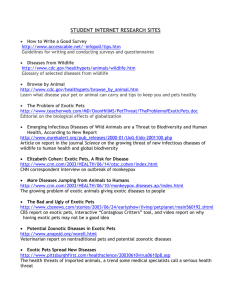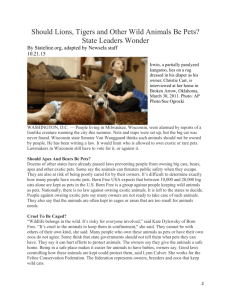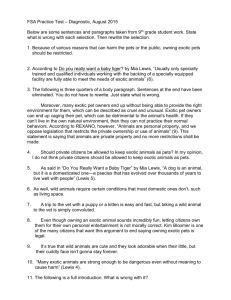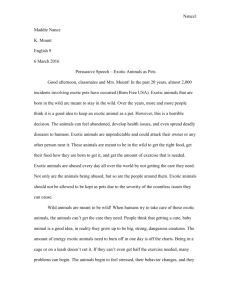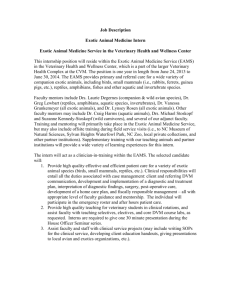File
advertisement
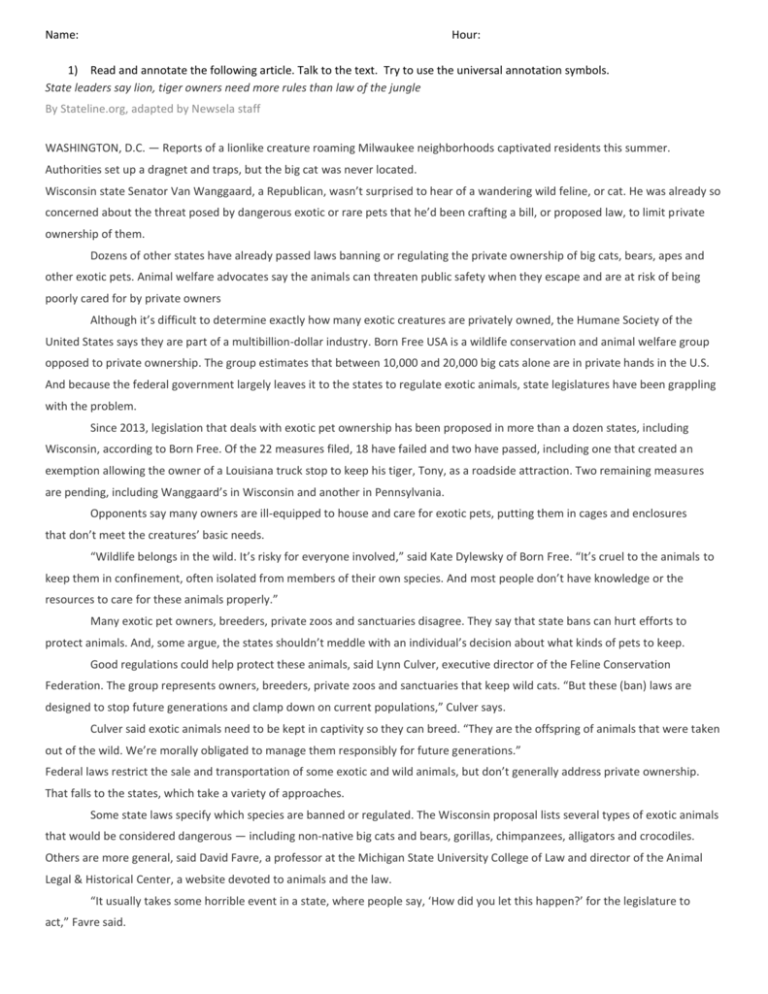
Name: Hour: 1) Read and annotate the following article. Talk to the text. Try to use the universal annotation symbols. State leaders say lion, tiger owners need more rules than law of the jungle By Stateline.org, adapted by Newsela staff WASHINGTON, D.C. — Reports of a lionlike creature roaming Milwaukee neighborhoods captivated residents this summer. Authorities set up a dragnet and traps, but the big cat was never located. Wisconsin state Senator Van Wanggaard, a Republican, wasn’t surprised to hear of a wandering wild feline, or cat. He was already so concerned about the threat posed by dangerous exotic or rare pets that he’d been crafting a bill, or proposed law, to limit private ownership of them. Dozens of other states have already passed laws banning or regulating the private ownership of big cats, bears, apes and other exotic pets. Animal welfare advocates say the animals can threaten public safety when they escape and are at risk of being poorly cared for by private owners Although it’s difficult to determine exactly how many exotic creatures are privately owned, the Humane Society of the United States says they are part of a multibillion-dollar industry. Born Free USA is a wildlife conservation and animal welfare group opposed to private ownership. The group estimates that between 10,000 and 20,000 big cats alone are in private hands in the U.S. And because the federal government largely leaves it to the states to regulate exotic animals, state legislatures have been grappling with the problem. Since 2013, legislation that deals with exotic pet ownership has been proposed in more than a dozen states, including Wisconsin, according to Born Free. Of the 22 measures filed, 18 have failed and two have passed, including one that created an exemption allowing the owner of a Louisiana truck stop to keep his tiger, Tony, as a roadside attraction. Two remaining measures are pending, including Wanggaard’s in Wisconsin and another in Pennsylvania. Opponents say many owners are ill-equipped to house and care for exotic pets, putting them in cages and enclosures that don’t meet the creatures’ basic needs. “Wildlife belongs in the wild. It’s risky for everyone involved,” said Kate Dylewsky of Born Free. “It’s cruel to the animals to keep them in confinement, often isolated from members of their own species. And most people don’t have knowledge or the resources to care for these animals properly.” Many exotic pet owners, breeders, private zoos and sanctuaries disagree. They say that state bans can hurt efforts to protect animals. And, some argue, the states shouldn’t meddle with an individual’s decision about what kinds of pets to keep. Good regulations could help protect these animals, said Lynn Culver, executive director of the Feline Conservation Federation. The group represents owners, breeders, private zoos and sanctuaries that keep wild cats. “But these (ban) laws are designed to stop future generations and clamp down on current populations,” Culver says. Culver said exotic animals need to be kept in captivity so they can breed. “They are the offspring of animals that were taken out of the wild. We’re morally obligated to manage them responsibly for future generations.” Federal laws restrict the sale and transportation of some exotic and wild animals, but don’t generally address private ownership. That falls to the states, which take a variety of approaches. Some state laws specify which species are banned or regulated. The Wisconsin proposal lists several types of exotic animals that would be considered dangerous — including non-native big cats and bears, gorillas, chimpanzees, alligators and crocodiles. Others are more general, said David Favre, a professor at the Michigan State University College of Law and director of the Animal Legal & Historical Center, a website devoted to animals and the law. “It usually takes some horrible event in a state, where people say, ‘How did you let this happen?’ for the legislature to act,” Favre said. That’s what occurred in Zanesville, Ohio, after a suicidal man released more than 50 big cats, bears, primates and wolves in 2011. Police and animal control officers tried to use tranquilizers, but couldn’t control the situation and were forced to kill most of the animals. At the time, Ohio had no law dealing with dangerous exotic pets. After the Zanesville incident, the Ohio legislature in 2012 banned having or acquiring exotic pets. Those who already owned such pets were allowed to keep them, but they had to apply for permits and comply with safety and care standards. In Connecticut, the legislature amended its law in 2009 to ban the private ownership of some primates. The amendment was adopted after an incident that year in which a woman was blinded, lost both hands and had much of her face ripped off by her friend’s 200-pound pet chimp. Wisconsin is one of five states without a law regulating the private ownership of dangerous exotic animals, according to Born Free. Fourteen states require licenses or permits. Twelve allow ownership of some exotic animals but prohibit others. And 19 have bans on a number of species. Last year, West Virginia, which had not had a law, passed a measure that prohibited private possession of lions, tigers, bears, elephants and most primates. Owners were grandfathered in, provided they are registered. The rules went into effect earlier this year. “When you don’t have any checks and balances in place, it was wide open for people bringing these exotic animals into our little state,” said former Democratic Delegate Randy Swartzmiller, who introduced the bill. “The majority of the Legislature saw this as a bill that was not only going to protect people but also the well-being of these animals.” But bills restricting or regulating exotic animal ownership often die in state legislatures. They either get voted down, or never get to a vote. This year, six measures failed — in Indiana, Kansas, North Carolina, Oklahoma, Virginia and Wyoming — according to Born Free. “In some of these states, it’s very hard to have a conversation about it,” said Born Free’s Dylewsky. 2) Who is the intended audience for this article? Write a complete sentence or more. 3) What is the author’s purpose in writing this article? Write a complete sentence or more. 4) Write a 1 paragraph summary that specifically includes and discusses the main/central idea 5) Write a 1 paragraph response to this article. What are your thoughts about this?
